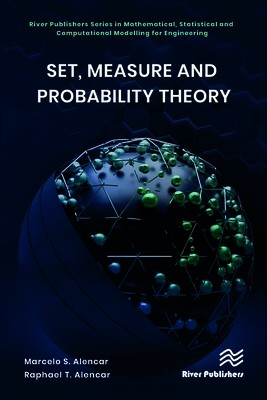
- We will send in 10–14 business days.
- Author: Marcelo S Alencar
- Publisher: River Publishers
- ISBN-10: 8770228477
- ISBN-13: 9788770228473
- Format: 15.6 x 23.4 x 1.8 cm, kieti viršeliai
- Language: English
- SAVE -10% with code: EXTRA
Reviews
Description
This book introduces the basic concepts of set theory, measure theory, the axiomatic theory of probability, random variables and multidimensional random variables, functions of random variables, convergence theorems, laws of large numbers, and fundamental inequalities. The idea is to present a seamless connection between the more abstract advanced set theory, the fundamental concepts from measure theory, and integration, to introduce the axiomatic theory of probability, filling in the gaps from previous books and leading to an interesting, robust and, hopefully, self-contained exposition of the theory.
This book also presents an account of the historical evolution of probability theory as a mathematical discipline. Each chapter presents a short biography of the important scientists who helped develop the subject. Appendices include Fourier transforms in one and two dimensions, important formulas and inequalities and commented bibliography. Many examples, illustrations and graphics help the reader understand the theory.
EXTRA 10 % discount with code: EXTRA
The promotion ends in 21d.17:41:08
The discount code is valid when purchasing from 10 €. Discounts do not stack.
- Author: Marcelo S Alencar
- Publisher: River Publishers
- ISBN-10: 8770228477
- ISBN-13: 9788770228473
- Format: 15.6 x 23.4 x 1.8 cm, kieti viršeliai
- Language: English English
This book introduces the basic concepts of set theory, measure theory, the axiomatic theory of probability, random variables and multidimensional random variables, functions of random variables, convergence theorems, laws of large numbers, and fundamental inequalities. The idea is to present a seamless connection between the more abstract advanced set theory, the fundamental concepts from measure theory, and integration, to introduce the axiomatic theory of probability, filling in the gaps from previous books and leading to an interesting, robust and, hopefully, self-contained exposition of the theory.
This book also presents an account of the historical evolution of probability theory as a mathematical discipline. Each chapter presents a short biography of the important scientists who helped develop the subject. Appendices include Fourier transforms in one and two dimensions, important formulas and inequalities and commented bibliography. Many examples, illustrations and graphics help the reader understand the theory.


Reviews